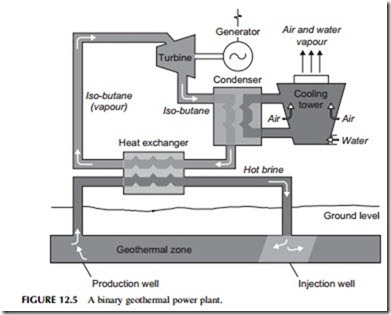BINARY CYCLE POWER PLANTS
Direct steam and flash geothermal power plants utilize geothermal fluid with a temperature between 180 oC to 350 oC. If the fluid is cooler than this, conventional steam technology will normally prove too inefficient to be economically viable. However, energy can still be extracted from the fluid to generate power using a binary cycle power plant. This type of plant has two fluid cycles: the first involves the low-temperature fluid from the geothermal resource and the second is a turbine cycle involving a low–boiling– point fluid (Figure 12.5).
In a binary power plant the geothermal fluid is extracted from the reservoir and immediately passed through a heat exchanger where the heat it contains is used to volatilize a secondary fluid. This secondary fluid is contained within a second, completely closed cycle system. The fluid may be an organic liquid that vaporizes at a relatively low temperature or, in the case of the Kalina cycle,1 a mixture of water and ammonia.
The vaporized secondary fluid is used to drive a small turbine from which power can be extracted with a generator. Once it has exited the turbine the secondary vapor is condensed and then pumped through the heat exchanger once more. Thus, the cycle is repeated. The geothermal fluid exiting the heat exchanger is, meanwhile, reinjected into the geothermal reservoir. Since 100% of the fluid is returned underground, this type of geothermal power plant has the smallest environmental impact.
Typical binary plant unit size is 1–3 MW, much smaller than for the other types of geothermal technology. However, the small modular units often lend
themselves to standardization, reducing production costs. Several units can be placed in parallel to provide a plant with a larger power output.
Although the normal application for binary technology is to exploit a low- temperature geothermal resource, the technology can also be used to generate more power from a flash plant. In this case the fluid left after flashing is passed through a heat exchanger before reinjection, allowing extra energy to be taken to power a small binary unit. Adding a binary unit to a conventional flash plant increases the cost but the resultant hybrid plant will have a larger power output.
